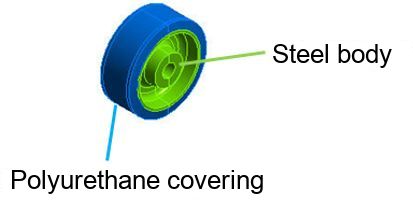For the FE- Calculation of rubber or plastic components, linear-elastic material models are generally unsuitable. For linear calculation, small strains are assumed. When calculating the strength of rubber or hyper-elastic plastics, we must assume both high strains and non-linear material behavior. The correct selection of the material model and the corresponding determination of the required material data often represent a challenge for the calculation engineer.
Learn more about how you can improve the function and quality of your products by using FEM calculation.
Simple example for the FEM calculation of a rubber damper (Mooney-Rivlin material model)
In this example, a rubber damper was examined in the context of an FE analysis using the Mooney-Rivlin material model. The corresponding material parameters were defined by the customer. The FE model shown here is only a small part of the component geometry but illustrates the material behavior quite well.
Selection of the suitable material model for the strength calculation of rubber and plastics (hyperelastic materials)
The selection of the correct material model for the FE analysis of rubber, plastics or similar hyper-elastic materials depends not only on the amount of the expected strains during the simulation, but also on the available material data. For high strains, the Mooney-Rivlin model is used if possible, since the Neo-Hooke model may not accurately represent them. Particularly in the course of preliminary investigations during prototype development, only a few test data are available that describe the material sufficiently accurately for the FEM calculation of the corresponding plastic or elastomer. Clues for the selection of the material model are among others:
- Magnitude of the expected strains
- Information from the material manufacturer (e.g. Shore hardness)
- available experimental data or material tests
FE analysis of rubber and plastics using the Mooney-Rivlin material model
The Mooney-Rivlin material model is a more complex nonlinear material model. It is defined with up to 9 parameters and also maps high strains well. It is used, among other things, for the FEM calculation of rubber parts such as seals, membranes, tyres, hoses, but also springs and rubber bearings. When using this material model, it must be ensured that the measurement data and measurement conditions for material characterization are similar to the later stress state of the component to be represented. We adapt customer-defined parameters by means of a curve fit with test results before they are used in the FE analysis of the respective plastic or rubber component.
FEM calculation of rubber and plastics using the Neo-Hooke material model
The much simpler Neo-Hooke material model allows the characterization of the hyperelastic material with only two parameters. These parameters can often be derived or converted from the manufacturers' data sheets, especially in the course of preliminary design. If, for example, a Shore hardness is specified for the material, the coefficients for describing the elastomer can easily be determined from this, at least roughly. However, the Neo-Hooke model for calculating the strength of rubber or plastic materials can only be used for smaller strains. For large strains > 200 %, the Mooney-Rivlin material model is recommended.
FEM calculation of a rubber roller (Neo-Hooke) within the scope of a customer project
Within the scope of a customer project, the unrolling of a drum with a large weight force on a polyurethane roller with a steel core is of great importance for the dimensioning of a securing device. The rubber roller is a purchased part for which the Shore hardness is specified by the manufacturer. The manufacturer's data sheet can be used to derive the required parameters for the Neo-Hooke material model.

Ultimately, the FEM calculation of the rubber roller, taking into account a frictional contact, shows that the amount and direction of the forces acting on the rubber rollers result in the drum being prevented from rolling and therefore there is no safety risk.
Further example projects for FEM calculations of component strength:
- FEM calculation of a stool with plastic components from the 3D printer
- FSI simulation of a cylinder head
- FE- calculation and force determination via rigid body simulation
- Practical FE- analysis example: Calculation of a pedestrian bridge
Are you curious ? Get an overview of our range of services and request our offer today !